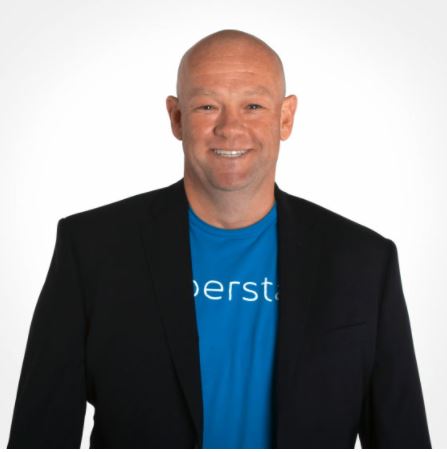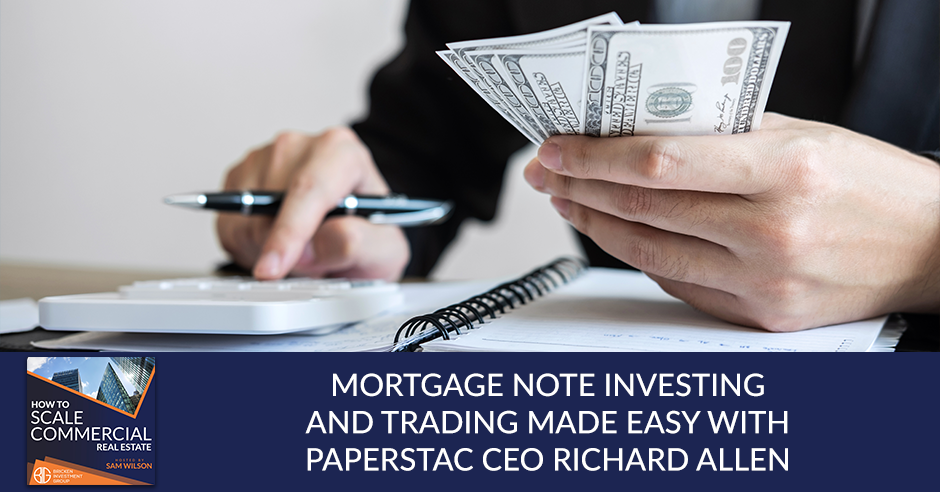Are you a real estate investor looking into mortgage note investing and trading? Then Paperstac is the platform of your dreams! Today’s guest is Richard Allen, the CEO and Cofounder of Paperstac, a platform where investors can come together in a safe and controlled environment to buy and sell mortgage notes. He joins Sam Wilson to talk all things note investing, trading, buying and selling, and how Paperstac is the best note marketplace to help investors. As Managing Partner at MWM Fund (Money With Meaning), Rick also shares how they’re helping people keep their homes and find alternative ways to pay off debt. Lend an ear to this insightful and educational discussion to learn more!
—
Listen to the podcast here:
Mortgage Note Investing And Trading Made Easy With Paperstac CEO Richard Allen
Rick Allen is a husband and father. He’s always been an entrepreneur. He loves to positively impact people’s lives and disrupt markets. Rick’s projects both revolve around the distressed debt market and disrupting how mortgage notes are traded. His company Paperstac is the first fully digital online process for buying and selling mortgage notes. As a Cofounder also at MWMfund, Rick and his team focused on deploying capital in the distressed debt space with the goal of managing economic returns and social impact. In short, they are saving people’s homes and giving back to the American dream of homeownership. Rick, welcome to the show.
Thanks, Sam. I appreciate it. I’ve been looking forward to this one for awhile. Thanks for having me.
The pleasure is mine. I asked the same question to everybody who came on. Can you quickly tell us where did you start? Where are you now? How did you get there?
I started buying distressed real estate, worked for a company that was sourcing inventory and then originating hard money for investors. This was back in the heyday, 2005, ‘06, ’07. In 2008, the market started to tank. I thought it’d be a good idea to go out and start my own investment company buying and selling real estate. It’s not the best time to start a real estate investment company but we were fortunate we had a good team around us. My partners and I ended up flipping about 400 houses between 2008 to the end of 2011.
At that point, one partner and I decided to liquidate our shares to the other third remaining partner. We were going to have a lifestyle business. I was going to raise my kids, play some golf, enjoy life, do some pics and flips and build a rental portfolio. That lasted for about three months. I ended up buying a mortgage note by accident. How I got into it was a $90,000 of debt on a frame duplex and I paid $8,400 for it. I ended up getting the house back and sold the property for $38,000. I did everything. In fourteen days, I didn’t put a coat of paint on the wall or anything.
I took it back and resold it. That set sail for my note journey. Along the way, there was a broken process we saw with how you buy and sell debt. There was nothing structured like real estate. There was no closing company and standard contracts. I was supposed to send money to the seller before they gave me a collateral package. We decided we wanted to fix that and created Paperstac. It’s an online trading platform for mortgage debts. It’s an automated process. It guides you from step one to the last step, cradle to the grave when you’re buying assets.
We were so good at buying and selling debt that we decided to do a structured fund. We’d been working with friends and family money. We went to the full route of going through the SEC and getting a Regulation A+ fund qualified by the SEC. We launched that in 2018. It’s been a journey. I feel like everything layered on top of itself to get us to where we are.
Let’s rewind this a little bit on the Paperstac side of things. Is Paperstac a DIY place for people to come and sell their notes? What is it?
It is a great way to look at it as a DIY place for people to buy and sell notes. We have a marketplace. It’s open to anybody. We don’t charge to become a member of Paperstac. We make a transaction fee when something closes. We’re able to give people an online marketplace but the secret sauce is what happens once you enter in and agree to buy something. The platform itself handles everything from the negotiations. It allows you to negotiate right on the platform. It generates all the documents for you.

You can store your vesting profile or how you want to take title to it. You can do everything from communicating right there through email or the transactional messaging system. You can even make a phone call on the platform. It’ll join you into a conference call, record it, transcribe your conversation and puts it right on your timeline. Everything for a single deal is in a siloed environment. You don’t have to go scouring through past text messages or emails or trying to recall phone calls. Everything happens right there on the platform.
How did you build it out? I know starting in tech and building a tech platform is no small undertaking. What were your keys to getting that done?
There’s this notch in the belt loop or bedpost, whatever you want to call it. For anybody who gets into tech, you start with, “I’m going to outsource my development overseas.” That’s what we did. We outsourced development, my partner, TJ and I. We vaporized about $30,000 on outsourcing. We weren’t getting great communication from the people who are outsourcing too.
I’m not a technical founder, so I don’t know anything about code. I’m proficient at Excel and email. I brought in a couple of guys, somebody I knew from college and I’d known for twelve years at the time, who I worked on another project which was a developer. I had him look at what we got back. He called it spaghetti code, which I assumed wasn’t a good thing.
I go, “Can you fix it?” He said, “No, you need to start from scratch.” TJ and I, who had founded the company, brought him in. His name’s Mike. He’s our fourth cofounder. We picked up Brett, who’s the marketing genius. He’s a professor part-time, teaches product launch, branding, SEO. He’s not only teaching it but he’s in the trenches on a daily basis. We’ve got a pretty strong team. We started redeveloping from the ground up.
We launched a beta version. We received great feedback on the beta version. We said, “Let’s rewrite the whole code system again.” This was in 2018. We rewrote it to what was at the time a brand-new cutting-edge technology, three months released with something called Firebase. We could nerd out on that if you ever wanted to but it’s some technical stuff. It’s a very technologically advanced platform.
It’s one thing to build a platform, but then how did you market it and bring in people that want to use it?
I’d been in the space for a while, buying and selling debt. We always attended conferences. We had a group out of Texas, a note school. Once we had been buying and selling debt, we went to them for some education, a mentorship type of deal, which they turbo-charged our investment strategies, but they always put on a big event. It was a lot of attending events and networking with people. Brett being the marketing guy has our pay-per-click stuff dialed in. The podcast was another one that we jumped out. We did a circuit of eleven podcasts when we launched, which are always great. It’s a huge way to put in a little time and touch a lot of people.
We talked about this being a DIY platform, but can the technology you have be institutionalized?
We’re doing a funding round to raise some capital to build out an enterprise product for institutions. Believe it or not, a lot of people are still trading, which is buying and selling, not to get too jargony but $100 million pools of debt through email and spreadsheets. It’s crazy. We were approached by a broker-dealer who did about $20 billion in 2020 in paper. They’re on pace to do $30 billion in 2021. This was right at the end of ’19. They said, “We’re going to think about building our own platform.” On the same day, two different people said, “You should check out Paperstac first.” They took a look at it and love it.
The answer should never be, “We just have to work harder.” If we hear a problem twice, solve it with technology.
They say, “You guys have a fresh look on it.” Traditionally buying and selling mortgage debt was an old boys club, predominantly older, gentlemen who were in the 50s, 60s buying, selling and trading the debt. Technology was not at the forefront. We’ve got a good advantage because we’re actively in the market buying and selling but also, we have a technical founder in-house. He’s as adept at buying and selling debt from seeing it happen. There is no box. You don’t even think outside the box. You let your mind run wild and see where it goes. Yes, it can be institutionalized. We’re mapping that out on what that development is going to look like.
I’m not in your industry but from what I’ve heard, it’s emails and phone calls. It’s pretty archaic in its own right. I would think that the larger buyers and sellers could garner a premium for what they’re buying and selling with the transparency you guys can provide.
The biggest thing they need is an efficiency tool, something that they can do transaction management with. I’ve done some institutional trades. I was shocked at how I was sending the same document four times or things were getting buried in email and I go, “You guys need Paperstac.” It makes everything in a siloed environment. If you’re the guy who’s in the C-Suite, maybe you’re a CEO, COO or something like that, it’s got this reporting dashboard that you can see everything along the way. It’s self-reporting.
One of the to-dos are checked off. It upgrades the progress on a percentage basis. We may go from 50% to 63%. That way, you can gauge your pipeline and see what you have going on, where your time delays are and which one of your employees isn’t doing what they need to be doing. It provides so much. The great thing is its technology, so it’s always improving. We have a motto that the answer should never be why we have to work harder. We have a 2X tech. If we hear a problem twice, let’s solve it with technology.
Let’s talk a little bit about your MWMfund. What is that about? While you’re buying debt, it’s also a completely different and very hands-on business, I would assume.
It is a very hands-on business. One of our founders, Terrence Osterman, has been spearheading that. My role in that has minimized other than looking at reports and having the sister company, Paperstac to help themselves. That is there but the fund itself, MWMfund, is Money With Meaning fund. We got into this business of buying and selling debt as a way to get houses, take houses back and foreclose.
After we had some education, we looked at it and said, “Let’s try to modify people’s loans, give them a short payoff or work with the borrowers and look at every other option other than foreclosure. Let’s explore all those options first.” We did one deal and had people crying on the phone because we were able to save their house. None of the banks would work with them. They treated them like dirt. We said, “That was great.” We made a good profit but more than that, we helped somebody out.
It was a good feeling. It was like, “I’m depositing some money into the bank but I’m also depositing stuff into the Karma bank or the feel-goods.” From there, we were like, “Let’s do that again.” We started doing that. We’d go, “This is great. Let’s open up a fund and manage with a double bottom line for profit and purpose.” That’s what the fund does. We try to save people’s homes.
If I’m reading between the lines here, you are buying at a discount and then able to pass on some of that discount to the borrower, renegotiate terms with them, rewrite the terms of their loan and then it’s a win-win. You’ve created your own upside in the deal. They have been able to reduce their payments. It’s something they can manage and continue to do.
You might buy something at $0.50 on the dollar. I’m throwing numbers out there. You can restructure their loan. Let them pay for six months. They’re happy they get to keep your house. You can turn around and sell it for $0.85 to $0.90 on the dollar after you’ve collected months of payments and stuff like that. It’s a win-win situation for everybody. Being a smaller fund and not having 25,000 assets, you can be a little bit more nimble and work with people. The question we love to ask is, “Tell me what happened. Why did you fall behind? Do you want to keep your house?” Let them talk. You’ll hear some incredible stories.

Correct me on this but with the distress debt inventory, is it lower or higher? What’s that market even look like?
It’s been dwindling up until 2020 but there’s this untalked about a backlog of, “There are people who aren’t making their mortgage payments.” You’re starting to see some of that stuff move through the pipeline. Q4 is such a hot time for buying and selling because sellers are rebalancing their books at end of the year. If they’re a buyer, got dry powder and capital to spend, they need to place it before the end of the year. Sellers need to rebalance their books.
You have this perfect storm of increased trading. Real estate has its summer buying months or the spring buying season of maybe April, May through August. On the debt side, I see huge spikes from trading in Q4. We’re gearing up for that. As a matter of fact, I was looking at our pipeline. It’s amazing. As soon as they hit Q4, the pipeline started building. It’s ridiculous.
Are you buying only on the single-family distress debt side or are you also looking at commercial assets?
The fund itself can buy anything backed by real estate. We made a pretty broad fund with a narrow altruistic focus but we were able to buy on the commercial side. We’re focusing strictly on the single-family. I do see commercial stuff funneling through Paperstac, though.
Scaling up that side of that business going back to the high touch side of it, that requires a lot of employees, phone time and research, even locating. I’m sure you get some bad tapes with phone numbers that don’t work or mailed a couple back returned.
That’s the nature of the beast. Systems are the key. We didn’t want to become bloated with huge payrolls because it starts driving down returns for their investors. We heavily rely on outsourcing, whether it’s through our loan servicers. We drive the strategy. We layout the detailed information, what we want to do. We have lots of systems in place to help scale. You can do horsepower or you can use some levers. We like to use levers.
We’ll have to wait and see how Q4 shakes out in this space. In 2022, I don’t know what your feelings on that area but I’m guessing it’s a crapshoot as to where it goes from here.
There are moratoriums expiring on foreclosure and evictions. When that stuff happens, it’s not going to be nearly as bad as 2008. It’s not going to be there. You’re going to start to see some inventory coming through the pipeline.
How do you guys find that inventory? I would assume this is a good old boy’s network. How do you go out and locate sellers?
There’s a lot of repeat business. We’ve been in it for over a decade. The Rolodex is priceless. We’re fortunate to have Paperstac because our social media is strong, LinkedIn, Facebook and YouTube. We’ve got our own podcasts and people are finding us on the Paperstac side saying, “Can you help me? Somebody brought us five assets in New York that were anywhere from $800,000 to $5 million in value.” Those deals are out there. People find you. I’m excited to be going back face-to-face for events. Are you in Texas?
No. We’re in Memphis, Tennessee.
We’re going to Texas in November 2021 for our first live in-person event. I expect it to be epic.
What are some gotchas in the distressed debt buying business?
There are three “gotchas” if you’re getting into the business: taxes, title, and blight.
There are three if you’re getting into the business. It’s taxes, title and blight. You want to make sure property taxes can erase your profits. I don’t recall Tennessee being as bad but somewhere a little bit North, Midwest, Ohio, Illinois and Indiana, those property taxes up there are insane. If you let some past due property taxes, you may find a couple of years’ worth that you missed. That can be $7,000, $8,000 a year. You start tacking on stuff. You’re like, “I got an $18,000 bill on something I paid $40,000 for. I paid another 50% in taxes.” That’s bad.
If you don’t have all your ducks in a row, need to foreclose and don’t have titles figured out, you can lose. You may be missing some transfers on the mortgage or the note. Those are big ones. I’ve seen stuff lost to taxes. Tax deeds were sold. In some states, you can get that back. In other states, it erases that first position lien.
Blight is if there’s wood over all the windows and every house on the street has got wood in the windows, you got to be wary about buying there. If you’re the only house in the neighborhood that’s got wood on the windows before you buy the debt and there are some nice houses around you, that’s a huge opportunity but if the whole neighborhood is beaten up, that’s a real opportunity to fail.
How do you guys take care of taxes, title and blight, those three items at scale?
It’s all outsourced. You order title reports, ownership and encumbrance reports, tax reports and drive-by BPOs from licensed real estate agents who will give you an assessment on value and take pictures of that house and other houses in the neighborhood. It costs you money. You got to spend money to make money. That’s part of the business.
It probably varies by location but what’s it cost per property in your due diligence phase?
It’s usually somewhere between $300 to $500, depending on what you’re doing. It’s not bad. Typically, the way it’ll work is whenever you get a tape of assets, you put in an indicative bid, which means, “Here’s my bid pending. There is no past due taxes. The value that you’re telling me is worth that. There are no issues with the title.” If you get in there and you legitimately find something like, “Here’s the value I’m coming up with. You got $20,000 in past-due taxes. I got to fade my bid,” you can back into it. Sometimes they’ll say, “Sorry, I’m handcuffed. I can’t do anything with it.” You’re like, “You’re out $500.” It is what it is.
For that $500, that’s an all-inclusive if you go the top route or you’re having somebody read through servicing notes, which every time somebody does something on loan. If the loan servicer talks to the borrower and they send the borrower something, they write down servicing notes. It’s saved us a few times where the house looked good on the outside but the servicing notes said, “Extensive damage from Hurricane Michael.” It’s one of those things. Having somebody else do that, read through all those notes and provide you with a report flying by instruments saves you.
I’ve learned a ton about your industry, how you guys have grown Paperstac and what you’re doing with the fund. A couple of last questions on the funds’ side of things. A reggae fund is not a cheap undertaking the launch. What is the size of the fund? Maybe it’s an evergreen fund. Maybe you can talk about that. What’s the size of the fund, if there is a size? How long before you’ve completely spent the funds inside of it?
We’re allowed to raise capital in June 2022 and then start winding it down. We have five years to disperse all the assets. We’re in a holding pattern because we’re going through our annual audit. I don’t know if you’re familiar with the supply chain line and building supplies. My buddy is a contractor and was like, “What used to take me three months to get windows is now eleven months to get windows.” It’s because of COVID.
It’s the same thing on the services side. Our audit, which should have taken 60, 90 days has been going on for 5 or 6 months. If somebody in the office gets COVID, everyone’s out. It’s been a giant drag. Once that’s open, we can start re-raising funds. It is a giant undertaking. We did the Regulation A + fund because you’re allowed to market to anybody. I can do pay-per-click ads. They don’t have to be accredited to invest in a fund. We take accredited and non-accredited investors. I probably wouldn’t do that again. I would probably focus strictly on a Reg D fund that would focus on our network of people that we know that would like to invest.

There’s a lot of talk out there with, “Invest as little as $100.” Why do you say that?
From what I found, some of the more credited investors are not necessarily calling you up every day wondering what’s going on. I’d rather spend the same money to talk to somebody who could invest $200,000 to $500,000, not to say the $200 investment. That’s our minimum. We did that because we like to make it available to the same people whose houses we’re saving. They should be allowed to invest. We honestly haven’t had very many $200 investments. Most of them have been higher but the amount of work that goes into handling everything.
I can only imagine. I was curious how that shakes out when you do a reggae fund with those low thresholds for entry and you’re answering the question. Everybody who raises money says the higher you go and the more money you can raise per chunk, the easier it gets.
The easier it is. We have a great fund management service. They handle everything. We don’t handle capital at all. I have access to the bank accounts. I look at it. I make requests but they do everything as far as taking money in, putting it in the proper spots and sending out wires. I just get to do the improving of them.
Rick, I’ve enjoyed this. I had a blast learning about your different companies, how you have scaled and why you only took three months to play golf and then went right back to work for the next decade. Maybe you’ll revisit that plan again someday.
That’s the goal.
I’ve certainly enjoyed this. Here are the final four questions. If I gave you $20,000 to invest in real estate, what would you do with it and why?
If you gave me $20,000, I would go buy either an owner-financed property or an owner-financed note. There are tons of those out there that you can get nice returns. You’ve double digit returns on there. They’re passive, so I would do that. Somebody offered me a house that says $20,000 down, owner-finance at 0% interest. That was one where I was like, “Send me the information. I’ll take a look at that.”
The second question for you is this. If you could help our readers avoid one mistake in real estate, what would it be? How would you avoid it?
It’s due diligence. The devil’s in the details. Make sure you run your property diligence on everything, whether it’s valuations or potential rehab that’s going to cost you. Try to understand all the costs that are going to come up along the way because there’s always going to be like, “I didn’t think about that. I didn’t know about missing the taxes.” That could nip in the bud. If you do your property diligence, the great thing about real estate is it’s generally insured both for hazard and title. At the end of the day, you can always go along and rent it out.
When it comes to investing in the world, what’s one thing you’re doing to make the world a better place?
We’re saving people’s homes. We’re treating people like people. They’re not Social Security numbers to our fund. We are about saving people’s house, making a difference and telling them to pass it on to somebody they need. That’s our philosophy and our motto within our fund.
Rick, if our readers want to get in touch with you, what’s the best way to do that?
You can reach out at Hello@Paperstac.com. Always reach out there and we’ll be able to get back to you. Google us and you’ll find us there. There’s our phone number. You can reach out and probably talk to Brett if you call.
Your MWMfund is also accepting investments as well.
As soon as we’re done with the audit, we will be. Because of the way the audit works, we have to pause during the audit and then you can start taking funds back in.
Stay on the lookout for that as well. Rick, thank you so much for your time. I do appreciate it.
Sam, thank you so much. I enjoyed it. Have a good one.
You too.
Important Links:
About Richard Allen
 Rick is a Husband and a Father and he has always been an entrepreneur. He loves to positively impact peoples lives and disrupt markets.
Rick is a Husband and a Father and he has always been an entrepreneur. He loves to positively impact peoples lives and disrupt markets.
Rick’s current projects both revolve around the distressed debt market and disrupting how mortgage notes are traded.
His company Paperstac, is the first fully digital online process for buying and selling mortgage notes. Paperstac.com
As a co-founder at MWM Fund, Rick and his team focus on deploying capital in the distressed debt space with the goal of managing for economic returns and social impact. In short, we are saving peoples homes and giving back the American dream of homeownership.

